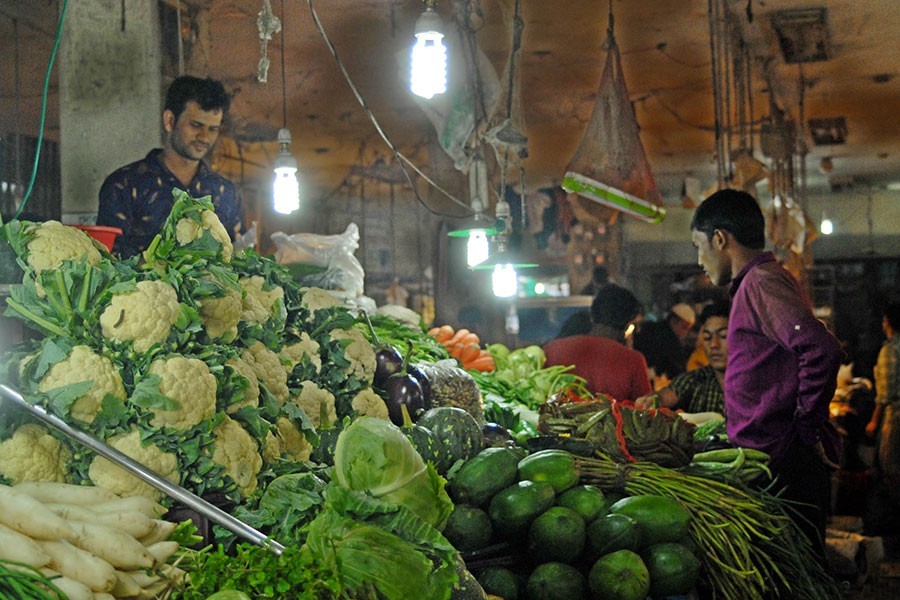Wage growth in Bangladesh remains stymied in relation to soaring headline inflation and the mismatch stokes concerns about shrinkage of people's real income and its compound fallout.
As a result of the gaping pay-and-price gap, economists say, limited-income people who are mostly breadwinners of their families are losing purchasing power.
The feared fallouts are reverting poverty rate, education dropout and malnutrition.
Bangladesh Bureau of Statistics (BBS) in its latest publication shows that the wage rate fell well short of consumer price inflation for July. The rate of nominal wage growth in July was 6.56 per cent on a point-to-point basis although the rate of inflation stood at 7.48 per cent--a gap of nearly 1.0 percentage point.
Similarly, the June wage growth was 6.47 per cent on a point-to-point basis against the inflation of 7.56 per cent.
In May, the same was 6.38 per cent against the inflation rate of 7.42 per cent. The inflation upturn in recent months mainly stems from the war in Ukraine that pushed up the prices of commodities on the international market.
The BBS measured Wage Rate Index (WRI) as an important indicator for measuring the trend and changes in the aggregate wages of the wage-earners.
The wage index is intended to measure movement of nominal wages of low-paid skilled and unskilled labourers over time in different sectors of the economy. It is also used to measure changes in real wages.
Economists familiar with the developments told the FE that the wage growth and the inflation rate had no gap in the past, and in some cases, wage growth was higher than the rate of inflation. But the gap now widens.
"The poor have lost their purchasing power as the inflation erodes the real income," says Dr Zahid Hussain, a former lead economist of the World Bank.
He anticipates the poverty rate may widen as a result of the gap. And malnutrition as a result of a poor diet may increase in the country.
Dr Hussain notes that the BBS data show the gap between wage growth and cost of living increase in the country which is now the largest in many years.
Another economist working at the Dhaka-based Economic Research Group (ERG) says, "There are many people who have migrated to rural areas during this covid-19 period and this has inflated the labour supply in the agricultural sector, leading to a fall in the wages."
The ERG economist, wishing not to be named, mentions that there had been a jump in the wages in the agricultural sector in the past, especially before the covid-19 period.
Dr Mustafa Kamal Mujeri, executive director at the Institute for Inclusive Finance and Development (InM), told the FE that if the rate of inflation exceeds the rate of nominal wage growth, then their real income gets eroded.
"This situation helps lower the standard of living of the people, especially the limited-income group of people," says Dr Mujeri.
"The poor people avoid the expense for healthcare services as a result of shrinking of real wages."
It also might lead to dropping out of education [for lower group of people].
Dr Mujeri mentions that there are some social protection programmes that exist in the country but the monthly or yearly allocation is very much poor to cope with the rising prices of essentials.
"The allocation of merely Tk 500 or Tk 1000 is not adequate to support people in maintaining their existing standard of living."
He feels that Bangladesh now needs a universal social-protection system that is based on fair targeting to combat such shocks.
The BBS measures the wages as the amount of money received either in cash or in kind in a day for standard daily working hours or earnings of low-paid labour who works on an hourly basis.
The wage index is intended to measure the movement of wages of low-paid skilled and unskilled labourers over time in main sectors of the economy, such as agriculture, industry, and services.
Wage Rate Index or WRI has been rebased from 1969-70=100 to 2010-11=100 under the main three sectors of the economy, such as agriculture, industry, and services, in respect of 44 occupations comprising 11 occupations from the agriculture sector, 22 from industry, and 11 occupations from services sector.


